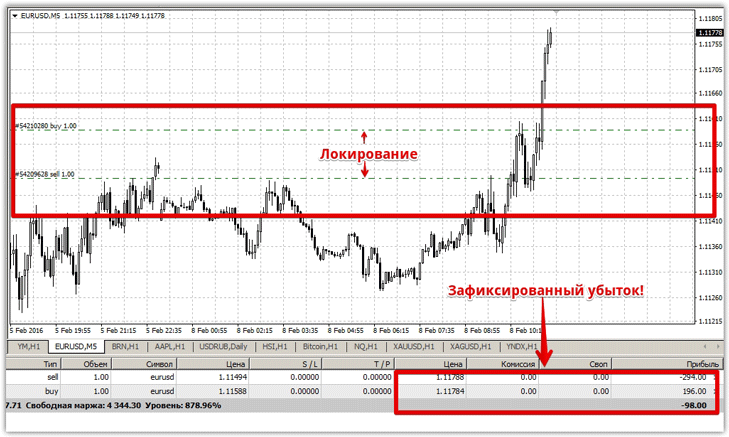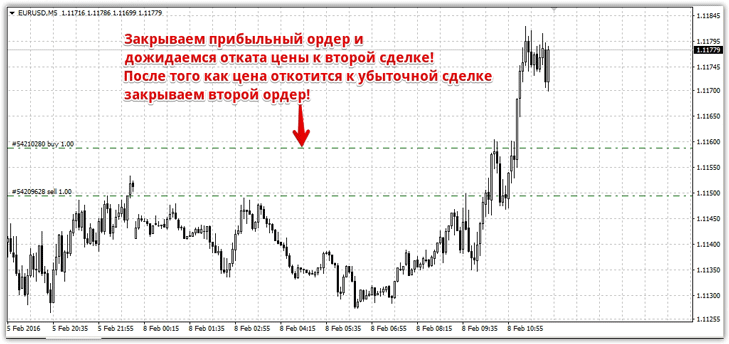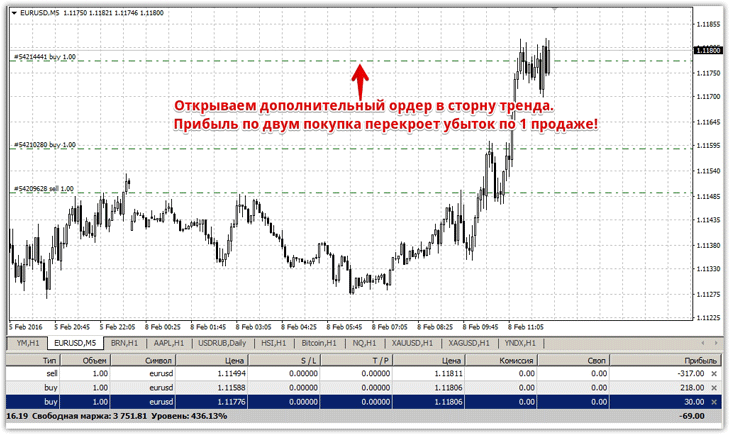Locking on Forex
 A competent approach to fixing losses and money management is, perhaps, one of the main components without which even the most profitable trading strategy will sooner or later become unprofitable.
A competent approach to fixing losses and money management is, perhaps, one of the main components without which even the most profitable trading strategy will sooner or later become unprofitable.
In essence, this is a special approach to fixing losses, which is delayed in time, although it requires large financial expenses on the part of the trader.
Unlike a standard stop order, where a loss is fixed immediately, a lock allows you to delay the closure of unprofitable positions, and with the right approach, turn the situation around with a plus for the trader.
What is locking in Forex?
Locking is fixing a loss without closing the position itself, which occurs by opening two opposite orders with the same lot. Simply put, at the moment when it is necessary to close a position with a loss, the trader opens a deal in the opposite direction with the same lot, and the distance in points between the orders is our recorded loss.
 In the picture above, the situation is clearly visible when the loss is taken into the castle by two orders. After such fixation, there is practically no difference where the price will go, because at the time of increasing the sale loss at the same moment, the profit for purchases is growing, and the loss in the form of a distance between these two multidirectional orders remains the same.
In the picture above, the situation is clearly visible when the loss is taken into the castle by two orders. After such fixation, there is practically no difference where the price will go, because at the time of increasing the sale loss at the same moment, the profit for purchases is growing, and the loss in the form of a distance between these two multidirectional orders remains the same.
However, it is precisely because of the time delay in fixing the loss that this approach is unique, since it becomes possible to decide on the correct tactics for exiting the lock in order to exit both positions with a profit or with a minimal loss.
How to get out of the lock
If everything is very clear with the creation of a fixed loss and a lock, then almost everyone faces enormous difficulties in getting out of this situation in their favor. So, let’s consider a couple of options for exiting the castle and alternative consequences that may develop if the situation does not change in our favor.
1) Closing a profitable position and waiting for a rollback to a losing position
This approach is one of the most popular and easiest. The whole process of closing a lock comes down to waiting for one of the orders to hit a support or resistance zone. When this happens, we close the profitable order and wait for the price to roll back to the opening point of the losing order, after which we close the second trade.
Ideally, we have a small loss on one of the orders and a profit on the second, which more than covers all our losses. However, this method has a disadvantage, since the price after closing a profitable order may move further and not roll back, which will lead to an increase in the size of the lock or a huge loss on the second trade.

2) Topping up with a second order following the trend
Unlike the previous approach to closing a lock, we must clearly determine the direction of the trend and open an additional transaction in the direction of the main trend with the same lot as the previous orders. In essence, we are averaging towards the global trend in the hope that the total profit on two positions will be able to cover the loss on one transaction.
The danger with this approach is that we may incorrectly guess the direction of the trend and, in addition to one losing position, we may take another one, which will lead to a further expansion of the lock and an increase in risk.
 In general, there are different approaches to closing the lock, and for the second method it is not necessary to use only the trend, since news is also suitable. The only thing you must understand is that locking in Forex is not a panacea for stop orders, but an exhausting approach that only experienced market participants can handle.
In general, there are different approaches to closing the lock, and for the second method it is not necessary to use only the trend, since news is also suitable. The only thing you must understand is that locking in Forex is not a panacea for stop orders, but an exhausting approach that only experienced market participants can handle.

